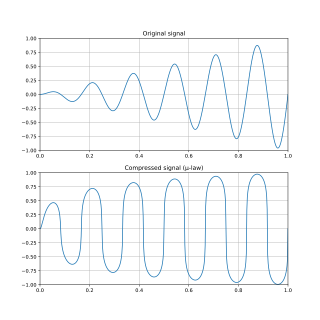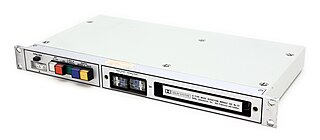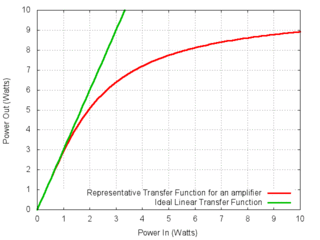
In telecommunication and signal processing, companding is a method of mitigating the detrimental effects of a channel with limited dynamic range. The name is a portmanteau of the words compressing and expanding, which are the functions of a compander at the transmitting and receiving ends, respectively. The use of companding allows signals with a large dynamic range to be transmitted over facilities that have a smaller dynamic range capability. Companding is employed in telephony and other audio applications such as professional wireless microphones and analog recording.

A Dolby noise-reduction system, or Dolby NR, is one of a series of noise reduction systems developed by Dolby Laboratories for use in analog audio tape recording. The first was Dolby A, a professional broadband noise reduction system for recording studios in 1965, but the best-known is Dolby B, a sliding band system for the consumer market, which helped make high fidelity practical on cassette tapes, which used a relatively noisy tape size and speed. It is common on high-fidelity stereo tape players and recorders to the present day, although Dolby has as of 2016 ceased licensing the technology for new cassette decks. Of the noise reduction systems, Dolby A and Dolby SR were developed for professional use. Dolby B, C, and S were designed for the consumer market. Aside from Dolby HX, all the Dolby variants work by companding: compressing the dynamic range of the sound during recording, and expanding it during playback.
A cassette deck is a type of tape machine for playing and recording audio cassettes that does not have a built-in power amplifier or speakers, and serves primarily as a transport. It can be a part of an automotive entertainment system, a part of a portable mini system or a part of a home component system. In the latter case it is also called a component cassette deck or just a component deck.

A mixing console or mixing desk is an electronic device for mixing audio signals, used in sound recording and reproduction and sound reinforcement systems. Inputs to the console include microphones, signals from electric or electronic instruments, or recorded sounds. Mixers may control analog or digital signals. The modified signals are summed to produce the combined output signals, which can then be broadcast, amplified through a sound reinforcement system or recorded.

Dynamic range compression (DRC) or simply compression is an audio signal processing operation that reduces the volume of loud sounds or amplifies quiet sounds, thus reducing or compressing an audio signal's dynamic range. Compression is commonly used in sound recording and reproduction, broadcasting, live sound reinforcement and in some instrument amplifiers.

Reel-to-reel audio tape recording, also called open-reel recording, is magnetic tape audio recording in which the recording tape is spooled between reels. To prepare for use, the supply reel containing the tape is placed on a spindle or hub. The end of the tape is manually pulled from the reel, threaded through mechanical guides and over a tape head assembly, and attached by friction to the hub of the second, initially empty takeup reel. Reel-to-reel systems use tape that is 1⁄4, 1⁄2, 1, or 2 inches wide, which normally moves at 3+3⁄4, 7+1⁄2, 15 or 30 inches per second. Domestic consumer machines almost always used 1⁄4 inch (6.35 mm) or narrower tape and many offered slower speeds such as 1+7⁄8 inches per second (4.762 cm/s). All standard tape speeds are derived as a binary submultiple of 30 inches per second.

dbx is a family of noise reduction systems developed by the company of the same name. The most common implementations are dbx Type I and dbx Type II for analog tape recording and, less commonly, vinyl LPs. A separate implementation, known as dbx-TV, is part of the MTS system used to provide stereo sound to North American and certain other TV systems. The company, dbx, Inc., was also involved with Dynamic Noise Reduction (DNR) systems.
David E. Blackmer was an American audio electronics engineer, most famous as the inventor of the DBX noise reduction system and founder of dbx.

Dolby Laboratories, Inc. is a company specializing in audio noise reduction, audio encoding/compression, spatial audio, and HDR imaging. Dolby licenses its technologies to consumer electronics manufacturers.
Noise reduction is the process of removing noise from a signal. Noise reduction techniques exist for audio and images. Noise reduction algorithms may distort the signal to some degree. Noise rejection is the ability of a circuit to isolate an undesired signal component from the desired signal component, as with common-mode rejection ratio.
Harman Kardon is a division of US-based Harman International Industries, an independent subsidiary of Samsung Electronics. Harman Kardon was originally founded in Westbury, New York, in 1953 by business partners Sidney Harman and Bernard Kardon.
A variable-gain (VGA) or voltage-controlled amplifier (VCA) is an electronic amplifier that varies its gain depending on a control voltage.

Harman International Industries, commonly known as Harman, is an American audio electronics company. Since 2017, the company has been operating as an independent subsidiary of Samsung Electronics.

Gain compression is a reduction in differential or slope gain caused by nonlinearity of the transfer function of the amplifying device. This nonlinearity may be caused by heat due to power dissipation or by overdriving the active device beyond its linear region. It is a large-signal phenomenon of circuits.

Audio & Design (Recording) Ltd are an English based company who specialised in the development and production of professional audio processors, in the form of limiters, compressors, expanders & equalisers. The company were one of the first to introduce Field-effect transistors into a commercially available limiter amplifier in 1966. Audio & Design (Recording) equipment has been widely used by professional studios, music artists and the broadcasting industry throughout the world. Recently the company has installed and serviced the BBC World Service's multi Terabyte archive installation using Storage area network technology (SAN).

In sound recording and reproduction, audio mixing is the process of optimizing and combining multitrack recordings into a final mono, stereo or surround sound product. In the process of combining the separate tracks, their relative levels are adjusted and balanced and various processes such as equalization and compression are commonly applied to individual tracks, groups of tracks, and the overall mix. In stereo and surround sound mixing, the placement of the tracks within the stereo field are adjusted and balanced. Audio mixing techniques and approaches vary widely and have a significant influence on the final product.
The Blackmer gain cell is an audio frequency voltage-controlled amplifier (VCA) circuit with an exponential control law. It was invented and patented by David E. Blackmer between 1970 and 1973. The four-transistor core of the original Blackmer cell contains two complementary bipolar current mirrors that perform log-antilog operations on input voltages in a push-pull, alternating fashion. Earlier log-antilog modulators using the fundamental exponential characteristic of a p–n junction were unipolar; Blackmer's application of push-pull signal processing allowed modulation of bipolar voltages and bidirectional currents.
The Blackmer RMS detector is an electronic true RMS converter invented by David E. Blackmer in 1971. The Blackmer detector, coupled with the Blackmer gain cell, forms the core of the dbx noise reduction system and various professional audio signal processors developed by dbx, Inc.
In magnetic tape recording, adaptive biasing is the technique of continuously varying the bias current to a recording head in accordance with the level of high-frequency audio signals. With adaptive biasing, high levels of high-frequency audio signals cause a proportionate decrease in bias current using either feedforward or preferably a negative feedback control system. Compared with the use of fixed bias current, adaptive biasing provides a higher maximum output level and higher dynamic range at the upper end of the audible spectrum and to a lesser extent, mid-range frequencies. The effect of adaptive biasing is most pronounced in compact cassette and low-speed reel-to-reel media. The first commercial implementation, the feedforward system Dolby HX was developed by Dolby Laboratories by 1979 and was rejected by the industry. The subsequent negative-feedback system Dolby HX Pro was developed by Bang & Olufsen and marketed by Dolby, and became the de facto standard of the consumer high fidelity industry in the mid-1980s.















